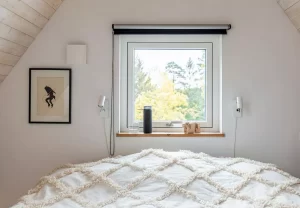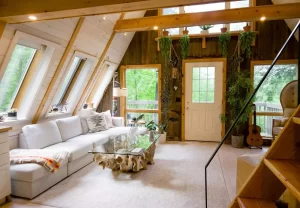

Table of Contents
Looking to add a little more space to your house? A loft conversion might be just the project for you. In most homes the loft is used for storage, but with a little love and elbow grease it can be transformed into a functional part of your living space.
On top of adding a whole new space to your home, converting your loft can add up to 20% to your property value! And work going on above your head can be less intrusive than adding extensions to the sides or back of the property and sacrificing precious outdoor space. But how should you go about planning this project? With this guide, we’ve got you covered.
Can I convert my loft?
The first thing you need to think about when starting a project like this is whether or not your loft is suitable to convert into a living space. Fortunately for you, most lofts are, but there are still three main things that you need to check beforehand.
Step 1: Check the internal height of your loft
This is pretty self-explanatory – you need to measure how high the roof is in the loft. The ideal height from the ceiling joist (the framing) to the ridge board (the top board at the highest point) should be at least 2500 mm.
Step 2: Check the pitch of your roof
This is where you measure the angle of your roof – generally, the higher the angle is, the more head room you’ll have in the finished space.
Step 3: Check the footprint of the space
Now you need to measure the internal space of your loft. Ideally, they should measure 5500 mm side to side, including chimneys, and 7500 mm front to back.

Planning your space
Now that you’ve ensured that your loft is suitable for conversion, you’ve got to think about what you’re going to use your new space for. Many families choose an extra bedroom for their expanding family or guest, or they instead convert it into a den or office for a peaceful workspace. Families with small children can also convert their lofts into playrooms that will become guest bedrooms as their children grow. If it’s big enough, you could even turn it into a studio apartment and rent it out for extra income.
The most important thing to think about when planning the use of a loft space is headroom – the angled ceilings will make it difficult for you to include certain pieces of furniture or use the space for certain functions. As a rule of thumb, lofts are close, cosy spaces best suited for sleeping, studying, or play.
DIY vs hired help
If you’re particularly handy, you might be tempted to convert your loft yourself. While this is entirely possible and might be cheaper in the moment, loft conversions present unique challenges that might involve your city’s planning department and a consultation with Building Regulations. To ensure that your project gets done correctly and executed smoothly, many experts recommend hiring a company to oversee your build.
The type of tradesperson you’ll need to hire varies – if you plan on being involved in your build and just need a bit of planning help, you could hire an architect or building surveyor to design the new space and obtain necessary permits and approvals for the project.
If you’re seeking to be a bit more hands off, you can hire either a specialist loft conversion company or an experienced builder. Loft conversion companies are generally one-stop-shops for design and building, but an experienced builder might be able to offer a similar service. Do your research beforehand so that you can hire a professional that best suits your project and your budget.
Choose your flooring
Every loft floor starts with boarding and it’s actually relatively simple to board your own loft, if you’re happy to DIY and keep costs down, with plenty of guides online like this one. From there, however, you have a flooring choice to make. The usual options are hardwood, carpet and laminate – just like any other floor in your house. Hardwood looks more modern, but also complements any exposed wood or beams in the loft. Carpet is ideal for bedrooms, as it’s cosy and keeps the room warmer. Laminate is a cheaper option with customisation opportunities and great for functional rooms like offices and playrooms.
Good windows are a must
Typically, your loft will offer you the best views of your local area, wherever that may be, so windows are essential. Plus, a loft can feel much smaller without any. The window style you choose will depend on the type of loft conversion you’ve opted for. The main types are dormers, gable-end and skylights. Dormer windows are the ones that you’d usually associate with lofts in the UK, vertical and seemingly cut out of the wall with extra headroom. Gable-end windows are more of a feature window, triangular in shape and great if you have a balcony. Skylights are amazing for light, but not so much the views unless you really love the sky.

Light the way
First and foremost, natural light is the saviour of any loft space, which is why the window choice is so crucial. For lighting fixtures, think about the ambience you want to create and work from there. Spotlights are a modern, minimalist option that will provide plenty of light and be less obtrusive. With more traditional ceiling lights, from pendants to chandeliers (if, for example, it became a walk-in wardrobe), you get to choose the placement of your lights – it doesn’t necessarily have to be in the middle. You may also want to get sockets installed behind any bedside tables for lamps.
Hidden considerations
Stairs
If you’re planning to integrate your loft into your home as a usable space, you’ve got to consider how you’re going to get up to it. Take regulations concerning stairs into consideration – you need a minimum two metres of head clearance both underneath and above the stairs so have a think about how the stairs will have to fit into your current floor plan.
Insulation
Occasionally, the loft areas of homes might not be insulated to the standards that the rest of the home are, and you might have to upgrade the insulation in the space before you start the conversion. Often, certification to have the work done will depend on having proper insulation in your space, so make sure that you build that possibility into your budget.

Lofts are a functional yet stylish addition to any house where you can achieve a level of cosiness that can’t be found anywhere else. Your only problem will be deciding who gets to use it – especially if you have teenagers looking to make it their own.
Looking for a loan to make your loft conversion happen? Check out our home improvement loans.



